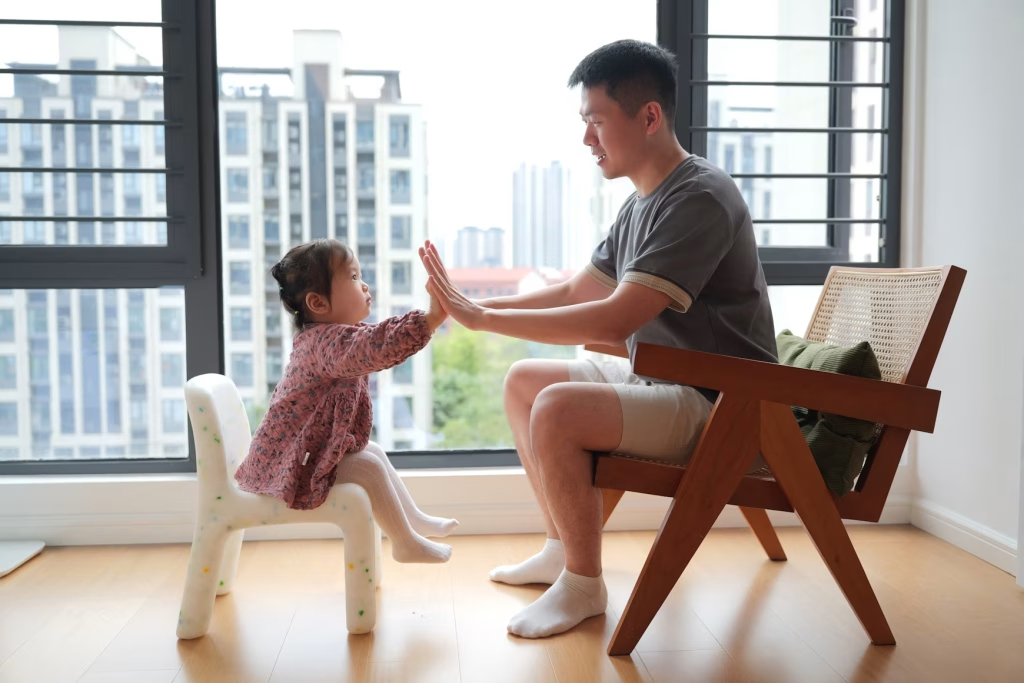
Some days with a toddler feel like living with a tiny whirlwind—one who hurls snack cups, insists pants are optional, and sobs because a banana broke “wrong.” If you’ve ever hidden in the pantry to regroup, you’re not alone. Difficult toddler behavior can upend even the most patient parent, but it doesn’t have to rule your household. With a handful of proven tools, a lot of empathy, and steady consistency, you can guide your child from meltdown to mastery and regain a sense of calm along the way.
Below are five expert-backed strategies that turn daily chaos into teachable moments. Each one is simple enough to start today and powerful enough to transform tomorrow.
1. Set Clear, Positive Expectations
Toddlers spend their days testing cause and effect: What happens if I throw this cup? How loud can I scream before Dad reacts? Vague commands like “Be good” or “Stop it” leave them guessing. Swap those for specific, observable directions:
- “Food stays on the table.”
- “Feet stay on the floor.”
- “We use indoor voices.”
Phrase expectations in the positive—tell your child what to do, not just what not to do. Research shows positive wording reduces stress and helps young children process instructions faster. Post simple picture cues at toddler eye-level (a pair of feet on the floor, a spoon staying in a bowl) to reinforce the message without constant nagging.
Parent shortcut: Before entering a store or restaurant, kneel to eye level and preview 1–2 rules. Toddlers remember better when the information is fresh, short, and interactive (“Can you show me what ‘walking feet’ look like?”).
2. Anchor the Day With Predictable Routines
Imagine an adult schedule that changed hourly with no warning—you’d melt down too. Toddlers crave predictability because it makes their big world feel safe. Establish consistent meal, nap, and bedtime windows; add micro-routines for tricky transitions:
- Play → Cleanup song → Snack
- Brush teeth → Pick two books → Lights out
Use a visual schedule with photos or drawings: breakfast plate, toy box, bath, pajamas. Point to the next step so your child sees what’s coming instead of feeling blindsided. Stable routines reduce tantrums because children spend less energy fighting the unknown.
Tip for shifts: Life happens—doctor visits, travel, relatives. When routine must change, give a toddler-sized heads-up: “After lunch, Grandma will pick you up. Then we’ll have playground time later.” Even a brief preview lowers anxiety.
3. Lead With Positive Reinforcement
Think of attention as fertilizer: whatever you water grows. If 90 percent of your words focus on whining, throwing, or yelling, guess what behavior blossoms? Flip the script: notice the good—loudly and often.
- “You shared your blocks. That was kind!”
- “Thank you for using gentle hands with the cat.”
- “Wow, you put your shoes on the first time I asked!”
Keep praise immediate and specific; pair it with a smile, high-five, or brief hug. Experts recommend a 4-to-1 ratio of positive to corrective comments for toddlers.
For minor misbehaviors (whining, foot stomping), try planned ignoring. When the unwanted action no longer earns a reaction, it often fades.
Mini-reward system: Place five clothespins on a “Fantastic Day” jar each morning. Each time you catch positive behavior, drop a pin into the jar so your toddler hears the clink. When all pins move, celebrate with a dance party or extra story—no candy needed.

4. Teach Emotional Skills Through Empathy
A toddler’s brain is under construction; the part that controls impulse and language lags behind raw emotion. Meltdowns are often cries for help, not defiance. Start with empathy:
- Name the feeling —“You’re mad your tower fell.”
- Validate —“It’s okay to feel mad.”
- Guide —“Let’s take two big balloon breaths and rebuild.”
Using feeling words builds your child’s vocabulary for self-expression.
Pair that with simple calming tools (blowing bubbles, squeezing a pillow, stomping like dinosaurs) and practice them outside crisis moments so the skills are ready when the storm hits. Children whose parents respond with empathy develop better emotional regulation and fewer behavior problems later (source).
Remember: you’re not indulging bad behavior—you’re teaching a life skill.
5. Sync Up With All Caregivers
Mixed messages confuse toddlers and undercut progress. Share your key phrases, routines, and reward systems with partners, grandparents, babysitters, and daycare teachers:
- Expectation: “Shoes stay on.”
- Cue: “Remember, walking feet.”
- Praise method: high-five + “Great listening!”
Regular 5-minute check-ins (text or voice memo) keep everyone aligned and allow quick tweaks: “Skipping morning nap made bedtime rough. Let’s keep the nap tomorrow.” If your child attends daycare, ask what strategies work there and mirror them at home. Consistency across environments accelerates learning and sparks confidence: rules are clear, adults are united, and the world feels less chaotic.
Keeping Yourself Calm While Teaching Calm
All the strategies above rely on one priceless ingredient—your composure. A dysregulated adult can’t coach regulation in a child. Build tiny self-care pauses into the day: sip water before intervening, breathe while counting to five, tag-team with a partner for a 10-minute reset. Modeling self-control shows your toddler that big feelings are manageable, not dangerous.
From Tantrums to Teach-able Moments
Difficult toddler behavior is normal, temporary, and (believe it or not) an opportunity. When you set clear expectations, ground the day in routine, highlight the positive, teach feelings, and team up with other caregivers, you’re not just surviving; you’re laying foundations for empathy, resilience, and self-discipline. That tiny whirlwind will calm in time, and thanks to your guidance, they’ll emerge ready to navigate the bigger storms life sends their way.
What tactic calmed your latest toddler tornado? Share your wins (and epic fails—we all have them) in the comments. Every story helps another parent feel less alone.
Read More
- 4 Cheap Recreational Activities for the Whole Family
- Tired of Chaos? Blunt Advice for Restoring Order at Home

Samantha Warren is a holistic marketing strategist with 8+ years of experience partnering with startups, Fortune 500 companies, and everything in between. With an entrepreneurial mindset, she excels at shaping brand narratives through data-driven, creative content. When she’s not working, Samantha loves to travel and draws inspiration from her trips to Thailand, Spain, Costa Rica, and beyond.